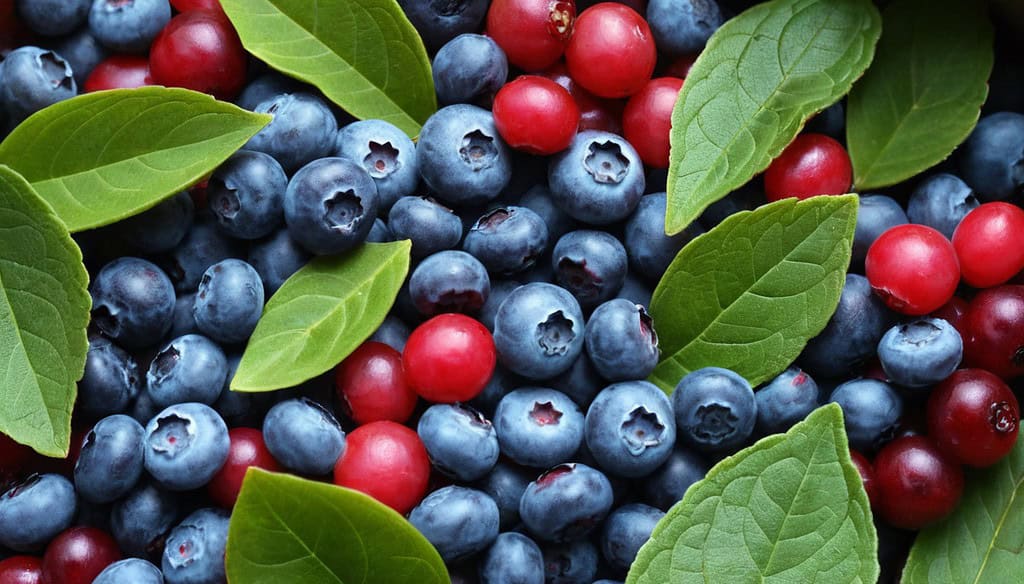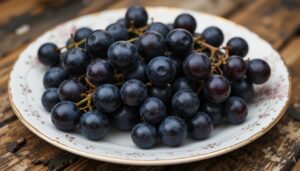Table of Contents
Ericaceae Fruits (Heath Family): Nature’s Delight

Ericaceae Fruits — Nature’s Delight
Ericaceae fruits, a true delight of nature, captivate fruit lovers worldwide with their unique flavors and impressive nutritional value. This family, also known as the Heath Family, features a diverse selection of berries and fruits, many of which have made their mark as some of the most popular and cherished fruits in the world. The vibrant offerings of this group, such as blueberries, cranberries, and huckleberries, are celebrated for their sweet and tangy profiles, tantalizing the taste buds with every bite. While some are enjoyed fresh, others find their place in a variety of culinary creations, from desserts to savory dishes.
The appeal of Ericaceae fruits goes beyond their delectable taste. Packed with antioxidants, vitamins, and minerals, these fruits offer a wealth of health benefits that make them an essential part of a nutritious diet. Blueberries, for instance, are rich in anthocyanins, and known for their potential to support brain health and combat inflammation. Cranberries, often praised for their high vitamin C content, have long been recognized for promoting urinary tract health. This blend of taste and wellness makes Ericaceae fruits a preferred choice for health-conscious individuals seeking natural and flavorful ways to nourish their bodies.
Ericaceae fruits are one of the most important fruit families and its importance cannot be understated. Their role extends across many cultures, impacting economies and culinary traditions alike. Beyond their household names, like blueberries and raspberries, lesser-known varieties add to the rich tapestry of this fruit family, each contributing to its global significance. By combining irresistible flavors with impressive health benefits, these fruits not only enrich the culinary world but also offer a natural source of wellness, making them truly a treasured gift from nature. Their versatility and nutritional power ensure their continued relevance and popularity worldwide.
In this article, we are going to talk about 8 of the most important Ericaceae fruits.
1. Blueberries

Blueberries are one of the most celebrated Ericaceae fruits, widely adored for their small, juicy bursts of flavor. They have a reputation for being both incredibly nutritious and versatile. Their sweet and slightly tart taste makes them a favorite among fruit enthusiasts and an ingredient of choice in a variety of culinary applications, from breakfast dishes like smoothies and pancakes to desserts like pies and muffins. The rich blue color of these berries comes from anthocyanins, powerful antioxidants that help protect the body from oxidative stress and inflammation. These beneficial compounds are believed to support heart health, improve cognitive function, and even aid in reducing the risk of certain chronic conditions.
Blueberries are often referred to as a superfood due to their impressive nutrient profile. High in vitamin K and vitamin C, they also provide dietary fiber, which supports digestive health and helps maintain steady blood sugar levels. One of the most appealing aspects of these Ericaceae fruits is how easily they can be integrated into different meals or consumed on their own as a snack. In addition to being low in calories, blueberries can be enjoyed fresh or frozen, maintaining their nutritional benefits in either state. Their vibrant flavor pairs well with both sweet and savory dishes, making them a staple in various cuisines worldwide.
The global demand for blueberries has only grown in recent years, reflecting an increased appreciation for their health benefits and culinary versatility. Commercial production is significant in regions with the ideal cool climate that blueberries require. These Ericaceae fruits thrive in acidic soil and benefit from the support of pollinators like bees. The cultivation and enjoyment of blueberries extend beyond mere taste, as their antioxidant properties have made them a symbol of wholesome nutrition and a dietary choice for long-term health benefits.
2. Cranberries

Cranberries are another highly important member of the Ericaceae fruits family, widely recognized for their tart and tangy flavor. These small, bright red berries have a distinct taste that balances acidity with subtle sweetness, making them perfect for a variety of dishes and beverages. Cranberries are especially popular in the United States, where they are a staple of holiday meals, particularly during Thanksgiving. Cranberry sauce, with its rich and tangy flavor, is a traditional accompaniment to roast turkey. Beyond their festive uses, these berries are also enjoyed in juices, dried snacks, and baked goods, contributing their unique flavor to a range of recipes.
One of the most notable attributes of cranberries is their impressive health profile. They are loaded with vitamin C, which supports the immune system, and are high in dietary fiber, contributing to gut health. Perhaps most famously, cranberries are celebrated for their ability to promote urinary tract health. This benefit comes from compounds known as proanthocyanidins, which can help prevent certain bacteria from adhering to the walls of the urinary tract. In addition, the antioxidants in cranberries help protect cells from damage caused by free radicals, potentially lowering the risk of chronic diseases.
Cranberries are predominantly cultivated in wetlands, often referred to as cranberry bogs, where they flourish in acidic, sandy soil. The berries are harvested using a process called wet harvesting, where the bogs are flooded, and the berries float to the surface for collection. As one of the Ericaceae fruits with a long history of traditional use and commercial significance, cranberries have made their mark both in culinary and health-related contexts. The berries continue to be a subject of scientific interest, as researchers explore their full potential in promoting well-being.
3. Huckleberries

Huckleberries are lesser-known but equally delightful members of the Ericaceae fruits family. They resemble blueberries in appearance but have a flavor profile that is uniquely their own. Huckleberries can range in color from deep red to dark blue and have a taste that combines sweetness with a hint of tartness, making them a wild delicacy for many foragers and nature enthusiasts. These berries grow naturally in the wild, especially in the forests of the Pacific Northwest in the United States. Because they are difficult to cultivate commercially, huckleberries often maintain a status as a rare and cherished find for those who harvest them.
Like other Ericaceae fruits, huckleberries are rich in antioxidants, which contribute to their health-promoting properties. These berries are particularly high in vitamin C and vitamin B, both of which are essential for various bodily functions, including maintaining healthy skin and supporting the immune system. Huckleberries are also packed with potassium, a mineral important for heart health and regulating blood pressure. The fiber content in these berries aids digestion and helps maintain a balanced gut environment, making them a nutritious addition to any diet.
Culinary uses for huckleberries are diverse. Their unique flavor lends itself well to jams, jellies, pies, and syrups, while also serving as a flavorful addition to savory dishes, such as sauces for game meats. The distinct taste of huckleberries has made them a beloved ingredient in regional cuisine, especially where they grow abundantly. Despite the challenges in cultivating these wild Ericaceae fruits, their nutritional benefits and extraordinary taste continue to attract attention from food lovers and health enthusiasts alike.
4. Lingonberries

Lingonberries, another standout among Ericaceae fruits, are known for their vibrant red color and robust, tart flavor. These small berries grow on low evergreen shrubs and are found throughout the northern hemisphere, particularly in the Scandinavian and Baltic regions. Lingonberries have a long history of use in traditional Northern European cuisine, where they are commonly made into sauces, jams, and syrups. Their tartness pairs well with savory dishes, such as meatballs or roasted game, providing a refreshing contrast that enhances the overall flavor experience. They are also enjoyed raw or sweetened to balance their natural astringency.
From a nutritional standpoint, lingonberries offer a wealth of health benefits. Like other Ericaceae fruits, they are packed with antioxidants, which help combat inflammation and protect against cellular damage. Lingonberries are also a good source of vitamins A, C, and E, contributing to immune support, healthy skin, and overall well-being. Additionally, these berries contain plant compounds that may help manage blood sugar levels and promote heart health. Research has suggested that lingonberries could have a beneficial impact on gut health, supporting a balanced microbiome due to their fiber content.
The cultural and economic significance of lingonberries cannot be overlooked. In regions where they grow abundantly, these berries are harvested both for personal use and commercial purposes. Lingonberry products have gained popularity far beyond their native habitats, thanks to their unique flavor and potential health benefits. The ability of these Ericaceae fruits to thrive in harsh, cold environments is a testament to their resilience, adding to their allure. As more people worldwide become aware of their nutritional advantages, lingonberries continue to captivate those who seek both flavor and wellness in their diet.
5. Bilberries

Bilberries, an essential part of the Ericaceae fruits family, share some similarities with their close relative, the blueberry, yet maintain a distinct identity. These small, deep blue berries grow wild in forests and heathlands throughout Europe and parts of Asia. Their flesh is darker compared to blueberries, and their flavor is often described as more intense, offering a richer and slightly more acidic profile. Bilberries are cherished for their role in traditional European cuisine, where they are commonly used in pies, jams, and pastries, or enjoyed as a natural snack when freshly foraged.
The health benefits of bilberries are significant, making them a valuable addition to the diet. They are packed with anthocyanins, powerful antioxidants that are thought to support eye health and protect against age-related macular degeneration. These compounds also play a role in reducing inflammation and may improve circulation, contributing to cardiovascular wellness. Furthermore, bilberries are rich in vitamin C and vitamin E, both of which are essential for immune function and skin health. Like other Ericaceae fruits, bilberries contain dietary fiber, which supports digestive health and helps manage blood sugar levels, making them suitable for a balanced diet.
Bilberries are not as commonly cultivated as other berries and are mostly harvested from the wild. They grow best in acidic and nutrient-poor soil, thriving in natural, undisturbed habitats. The demand for these berries, both for culinary and medicinal purposes, has remained steady throughout the years. Their deep, complex flavor makes them a favorite in various recipes, especially when used to create vibrant desserts or flavorful sauces. As one of the more specialized Ericaceae fruits, bilberries continue to hold cultural significance in many parts of the world, celebrated for both their taste and nutritional benefits.
6. Bearberries

Bearberries are unique members of the Ericaceae fruits family, known for their ability to thrive in harsh and frigid environments. These small, bright red berries grow on low-lying shrubs across the northern hemisphere, particularly in arctic and subarctic regions. The term “bearberry” is derived from the observation that bears have a strong preference for these fruits. The berries have a tough, leathery texture and a somewhat bitter, astringent taste, making them more suitable for processing into teas, tinctures, or dried snacks rather than being eaten raw. Despite their somewhat challenging flavor, bearberries have long been used in traditional medicine.
The health benefits of bearberries are well-documented, particularly for their use in supporting urinary tract health. They contain compounds like arbutin, which can have antiseptic properties. These natural compounds are believed to aid in preventing and alleviating urinary infections. Additionally, bearberries are rich in antioxidants, helping to combat oxidative stress and inflammation in the body. These Ericaceae fruits are also a source of vitamins A and C, which are important for skin health and immune support. The leaves of the bearberry plant are often used in herbal remedies, further expanding the plant’s role in traditional healing practices.
Bearberries are incredibly resilient, growing in acidic, sandy, or rocky soils where few other plants can survive. They are an important part of the ecosystem, providing food for wildlife in regions where resources are scarce. Although bearberries are not widely used in everyday cuisine, they have a place in cultural traditions and are sometimes used in recipes that embrace their astringent qualities. The hardy nature of these Ericaceae fruits makes them a symbol of survival and adaptation in some of the world’s most challenging climates.
7. Salal Berries

Salal berries are among the lesser-known yet equally valuable Ericaceae fruits. These dark purple berries grow on dense, evergreen shrubs along the Pacific coast of North America, from California to Alaska. Salal berries have a rich, sweet flavor with an earthy undertone, making them a delightful treat for those who come across them in the wild. Indigenous peoples of the region have long relied on salal berries for both nutritional and cultural purposes, often using them in dried form or as a key ingredient in traditional dishes.
Nutritionally, salal berries are a powerhouse, containing high levels of antioxidants, vitamins, and minerals. They are rich in dietary fiber, promote healthy digestion, and provide essential nutrients like vitamin C and manganese. The antioxidants present in salal berries contribute to reducing inflammation and may help protect against various chronic diseases. The natural sugars in these berries make them an energy-boosting snack, while their fiber content helps regulate blood sugar levels. Like other Ericaceae fruits, salal berries have health-promoting properties that make them a valuable addition to a varied diet, even if they are not as widely recognized as blueberries or cranberries.
Salal berries are incredibly versatile in the kitchen. They can be eaten fresh, added to desserts, or used to create jams and preserves that capture their unique flavor. They are also known for their use in making berry wines and syrups. The dense and hardy salal shrubs not only provide a food source but also play a vital role in stabilizing soil in forested areas and providing shelter for wildlife. As more people discover the benefits and versatility of these Ericaceae fruits, salal berries are gaining popularity beyond their traditional regions, appreciated for both their taste and ecological importance.
8. Wintergreen Berries

Wintergreen berries are another fascinating example of Ericaceae fruits, notable for their refreshing, minty flavor. These small, bright red berries grow on evergreen shrubs native to North America, particularly in the eastern United States and Canada. The plant’s leaves and berries have a distinct wintergreen aroma, which is due to the presence of methyl salicylate, a compound that is also found in many pain-relieving balms and ointments. Wintergreen berries have a unique flavor that is often enjoyed in small quantities, either fresh or used to infuse flavor into teas and confections.
The health benefits of wintergreen berries are closely tied to the plant’s medicinal uses. The berries and leaves have been used traditionally to relieve pain and inflammation, thanks to their natural salicylate content, which functions similarly to aspirin. Wintergreen berries are also a source of vitamin C, supporting immune health, and contain antioxidants that help fight free radicals. Despite their medicinal properties, these Ericaceae fruits should be consumed in moderation, as large quantities may have adverse effects. The oil extracted from wintergreen leaves is potent and must be used carefully, particularly in traditional and herbal medicine.
Wintergreen shrubs thrive in acidic soil and are often found growing in shaded, forested areas. The berries are an important food source for various wildlife, including birds and small mammals, during the colder months. Humans have also found creative ways to incorporate wintergreen’s unique flavor into products like chewing gum, candies, and essential oils. The distinct taste and aroma of wintergreen berries make them a memorable part of the Ericaceae fruits family, valued for both their culinary uses and their longstanding role in natural healing practices. As people continue to explore the rich variety of Ericaceae fruits, wintergreen berries stand out for their unmistakable minty profile and their contributions to traditional medicine.
Disclaimers: *This article is only for informational purposes.
**Do not make your important decisions based solely on the information provided in this article. Do your own research.
***Information in this article may vary or get updated in the future.
****Contact a doctor or a medical professional for any medical emergency.
Read More Science and Space Articles
- 8 Incredible and Healthy Cucurbitaceae Fruits to Enjoy
- Top 8 Delicious Anacardiaceae Fruits You Must Try
- 8 Incredible Musaceae Fruits You Need to Try Right Now
- 8 Incredible Vitaceae Fruits: Nature’s Tasty Treasures
- 8 Incredible Rosaceae Fruits You Need to Discover
- 8 Amazing Citrus Fruits That Will Brighten Your Day
- 8 Non-CO₂ Greenhouse Gasses That Are Worst Than CO₂
- Chemistry: 8 Unique Ways to Become Efficient At It
- 8 Ways Water Crisis is Worsened by Global Climate Change
- 8 Amazing Ways Brain Anatomy is Altered by New Learning
- 8 Disastrous Ways Deforestation Destroys Biodiversity
- Mathematics: 8 Interesting Ways To Become Efficient At It
- 8 Worst Ways Global Climate Change Hurts The Impoverished
- Danger Of Environmental Damage: 8 Ways A Person Can Help
- Eradication Of Poverty: 8 Critical Ways Science Helps
- STEM Fields: 8 Important Reasons Why You Must Learn Them
- Making Your Kid Efficient At STEM Subjects: 8 Important Steps
- Making Your Kid Science Enthusiast: 8 Important Steps
- Becoming A NASA Aspirant: 8 Important Steps You Must Follow
- Top 8 Important Wellness Habits That You Must Follow
- Top 5 Amazing Whole Grains That Are Healthier Than Rice
- Indian Space Program: 8 Incredible Achievements
- China’s Space Program: 5 Amazing Accomplishments
- Discoveries by JWST: 10 Incredible Findings of The Telescope
- NASA’s MOXIE Creates O2: Big Step Towards Mars Colonization
- Top 5 Amazing Properties of Time That Defy Common Sense
- 10 Factors for Emergence of Intelligent Life in The Universe
- Space Science: 6 Vital Reasons Why We Should Invest in It
- Solar System: 10 Astonishing Uniqueness of our star system
- Our Universe: An Incredible Journey of 13.7 Billion Years
- Top 6 Solar System Objects That Might Destroy Life On Earth
- Certain End of The Universe: 4 Forces of Nature to Watch Out For
- Big Bang: An Incredible Start of Universe 14 Billion Years Ago




